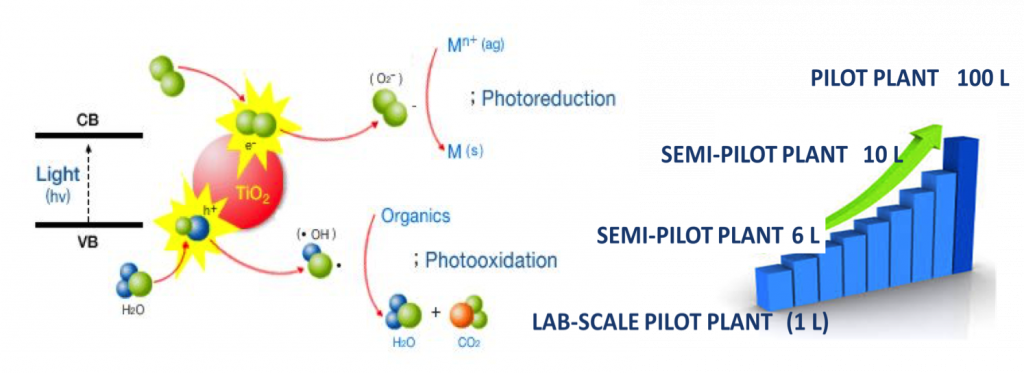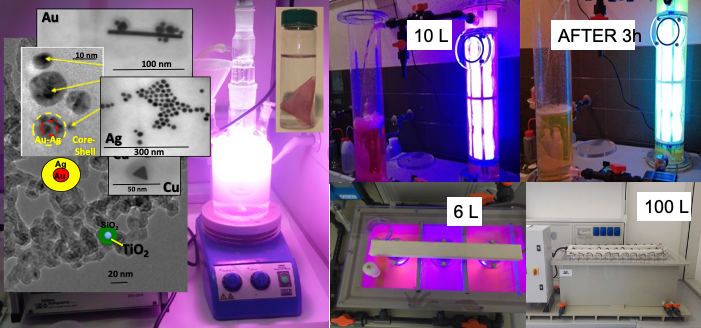This website uses cookies so that we can provide you with the best user experience possible. Cookie information is stored in your browser and performs functions such as recognising you when you return to our website and helping our team to understand which sections of the website you find most interesting and useful. More information in our Privacy Policy
Nanotechnologies applied to water purification
Advanced oxidation treatments of chemical pollutants using photo / electrocatalytic systems
Principal investigator: Anna Luisa Costa
Involved personnel: Magda Blosi, Carlo Baldisserri, Andrea Brigliadori, Antonio Crimaldi, Lara Faccani, Davide Gardini, Simona Ortelli, Marina Serantoni, Felice Carlo Simeone, Ilaria Zanoni
The photocatalytic technology used in advanced oxidation processes of recalcitrant aqueous pollutants, in addition to traditional purification treatments, offers the possibility of mineralizing organic substances by oxidizing them to non-polluting elementary molecules (CO2 e H2O) without using disinfectants that are potentially harmful to the ecosystem. In order to make this technology industrially relevant, increasing scale level plants have been designed and built at ISTEC, from laboratory plant (1/2 L) to semi-pilot plants with different geometries (6 L and 10 L), to real pilot plant with 100 L capacity.
Target pollutants
Microplastics are increasingly present in aquatic environment and are recognized as potentially toxic to fauna and flora. The presence of microplastics in water changes the life cycle of living beings who use them to feed themselves with harmful effects on their digestive system. Microplastics also alter the physico-chemical properties of sandy and coastal sediments.
The main degradation strategies for microplastics are biodegradation and photo-oxidation. In ISTEC are under study new methods for identifying and characterizing plastic pollutants (micro-nano plastics) with the aim of designing new degradation methods.
Other targets are heavy metals present in polluted waters, these are recognized as toxic to the aquatic environment and to humans. A composite material TiO2@microalgae was studied in ISTEC, it allows to exploit both the photocatalytic activity of titanium dioxide and the biosorption capacity of heavy metals by microalgae. Research results showed a positive synergistic effect promoted by the dispersion of the microalga on the surface of the oxide.
Nanostructured materials for pollutants removal
Titanium dioxide (TiO2)
ISTEC’s activity on water purification is mainly focused on the use of nanometric TiO2 as an active phase in the photocatalytic oxidation process (i.e. TiO2@SiO2, TiO2@microalgae) and applied on textile and metal supports. TiO2 granules from micro to milli metric dimensions are also produced to be used in suspension or in fixed or fluid bed systems.
Hydrotalcite
Composite photocatalytic materials are under study such as hydrotalcite (Hydrotalcite-like compounds, HTlc): double layers hydroxide MII (i.e. Mg, Zn) and MIII (i.e. Al, Fe), characterized by adsorbent and anion exchange properties, useful as photoactive doped semiconductors in the UV-VIS range of the electromagnetic spectrum.
Processes
Electrochemical/photocatalytic degradation of organic pollutants
Electrochemical degradation of organic pollutants present in industrial and sewage wastewaters can be performed in electrochemical cells having a volume from a few mL to several m3. The electrochemical degradation process is based on the anodic oxidation of pollutants at oxidized TiO2/Ti anodes in the presence of a platinum group metal (Pt, Pd) acting as a catalyser. To maximize the oxidation yield of the system, electrochemical cells for the anodic oxidation of organic pollutants are designed as recirculating flow cells.
Coupling photocatalytic and electrochemical oxidation in the same reactor is also possible under UV irradiation, allowing an increase of the system’s oxidation yield. Several anode/support electrolyte combinations are being studied, as well as the dependence of the oxidation yield of the coupled photocatalytic/electrochemical system on the type of anode and supporting electrolyte employed. Both model polluted systems such as Rhodamine B in water, and polluted industrial wastewaters are used in the experiments.


Projects
Pubblications
- I. Zanoni, M. Blosi, V. Fiorini, M. Crosera, S. Ortelli, S. Stagni, A. Stefan, S. Psilodimitrakopoulos, E. Stratakis, F. Larese Filon, A. L. Costa, Use of Cotton Textiles Coated by Ir (III) Tetrazole Complexes within Ceramic Silica Nanophases for Photo-Induced Self-Marker and Antibacterial Application, Nanomaterials, 10, 1020 (2020).
- S. Ortelli, A. L. Costa, C. Torri, C. Samorì, P. Galletti, C. Vineis, A. Varesano, L. Bonura, G. Bianchi, Innovative and Sustainable Production of Biopolymers, T. Tolio et al. (eds.), Factories of the Future (2019) – Book chapter.
- C. Baldisserri, S. Ortelli, M. Blosi, A.L. Costa, Pilot- Plant Study for the Photocatalytic/Electrochemical Degradation of Rhodamine B, Journal of Environmental Chemical Engineering, 6, 1794–1804 (2018).
